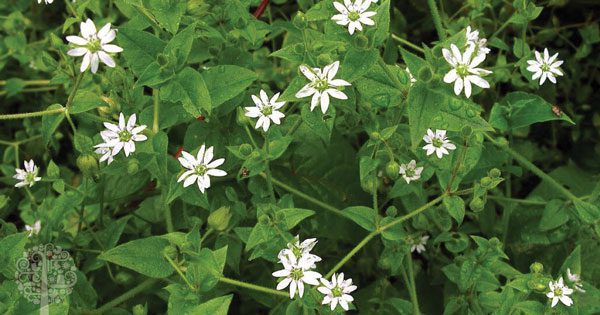The summer harvest might be well behind us, but we still have time to gather some tasty wild weeds! Foraging is an excellent way to add nutritious food to your diet just before the snow flies. Chickweed, or Stellaria media, is perfect for picking in the fall because it loves colder temperatures.
What It Looks Like

Chickweed is also commonly referred to as starweed, and it’s easy to identify. With its bright green color, ovate-pointed leaves, and tiny white star-shaped flowers, chickweed is one of the first plants to sprout in the spring and one of the only to remain vibrant into the fall, sometimes even after a light frost.
Where To Find It
This weed is easy to find as it grows in a wide variety of habitats such as pastures, cultivated fields, gardens, and lawns. If you have a greenhouse, it might even be spreading between the rows.
Look-Alikes
The closest look-alike to chickweed is Cerastium fontanum, also called mouse-ear chickweed. Even though this imitation is edible, it is fibrous and hairy, so it isn’t as palatable as common chickweed.
Be sure you know what you are looking for; chickweed can be mistaken for non-edible plants such as Persian speedwell, Veronica persica, and scarlet pimpernel (Anagallis arvensis).
The Taste
You can prepare chickweed in many ways, but eating it raw is best. It has a crisp, mild taste similar to fresh lettuce and corn silk. The young shoots are best for picking; add them to salads, wraps, and sandwiches for some summertime flavor!
You can also opt to use chickweed instead of basil in a delicious pesto recipe. Make a big batch and freeze it so you can enjoy it year-round. The wild weed is also a great addition to omelets, casseroles, and soups.
In wartime, chickweed was immensely popular as it was available for a more extended period in the growing season than other garden veggies.
Good For The Body
Chickweed is a mineral-rich food source and contains iron, copper, calcium, sodium, manganese, phosphorus, zinc, magnesium, and silica. Vitamins A, B, and C are plentiful, and the fibers in the plant help absorb other nutrients.
This humble little weed has many wonders to share and is still available for picking before the snow sets in. So grab a basket for foraging and savor the flavors of summer a little longer while reaping the benefits of this wild weed!